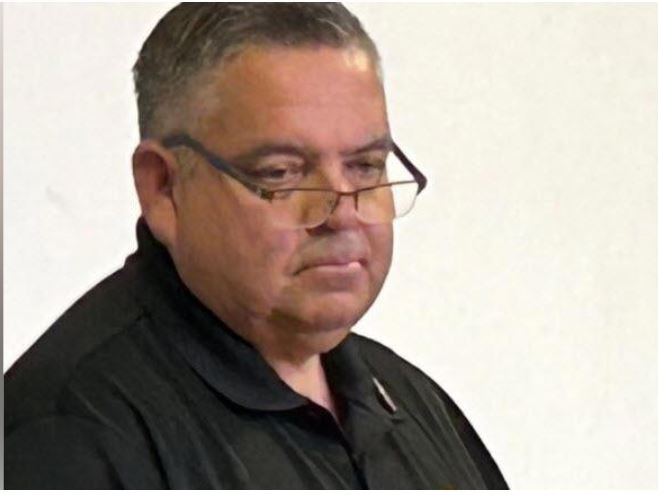SLPD continuing investigation against former employee
www.yumasun.com
BYLINE: CESAR NEYOY, BAJO EL SOL
http:///news/police-53015-evidence-investigation.html
Link to Article
One Photo
San Luis, AZ
SAN LUIS, Ariz. - Even if no formal charges have been filed, the San Luis Police Department is far from completing its investigation into allegations a former police employee stole or mishandled money and drugs she was supposed to be safeguarding as evidence, the city's interim administrator said.
In an interview with Bajo El Sol, San Luis City Administrator Jeff Philpot sought to counter what he called misperceptions that the police department bungled a "complex" investigation into Esperanza Zambrano's conduct as police evidence technician.
Philpot also disclosed that one of her duties had been to write new procedures to safeguard evidence seized by police in criminal cases.
Zambrano was arrested by police Sept. 16 after an investigation into the disappearance of $3,000 and 180 grams of methamphetamine from evidence storage. The money and drugs turned up missing while she was employed as the evidence technician, police said, and the investigation began when suspicions surfaced after she quit her job in December.
Somerton Justice of the Peace Jorge Lozano ordered Zambrano released from the Yuma County jail on Sept. 17 because police didn't bring her before him for her initial appearance until three hours after the 24-hour deadline normally prescribed by state law. Police said the delay was reasonable because they were still gathering evidence in the case and because Lozano's court did not open until three hours after the deadline.
The Yuma County Attorney's Office declined to file formal charges against Zambrano by Monday's deadline. Prosecutors, however, asked the police department to renew the investigation so they can determine whether to file a complaint later on.
"With respect to the case, I believe it was investigated and presented appropriately," Philpot said. "The police department did outstanding work. But while there is still much to do, the investigation continues, the information will be sent for review to the county attorney and eventually the decision will be made about whether to file charges against Zambrano.
"I don't consider it a failure," he added. "I understand how big and complex this case is. Those who read the news in the newspapers or who saw it in 30-second television clips will form their own opinions based on that, but they don't understand how complex the case is. It's very easy to say, 'Look, San Luis police failed again,' when they don't have all the information."
He said the investigation occupied two people full time and required a review of every piece of evidence from every criminal case entered into storage in the evidence room.
The department got no help from any outside agency in doing the internal investigation because "they have the same problems with personnel shortages and limited resources that all agencies have," Philpot said.
"I don't think the public understands that. This hasn't been and will not be like an auto theft case, where there is an investigation and the person who stole it is arrested. It's much more complex than that.
"Our system is designed to keep the bad people out, as if you were to put a lock on your house. But it isn't prepared for when we have the bad inside."
The police department did a good job in building case against Zambrano, said Philpot, but the next step is "going to court and prosecuting it. The county attorney has to prove to a jury that that person committed the crime, basing it on the proof and evidence we present.
"There are two different requirements in this case: We feel there was sufficient grounds to arrest Zambrano; now the challenge is having sufficient evidence to prove to a judge that she committed a crime.
"We live in a great country, with freedom of expression," Philpot said. "Anyone can have an opinion, but that doesn't mean they're right. It wasn't a failure by the police department. There are different standards that have to be met, more work to do, but the case is far from being closed."
Zambrano became an evidence technician for the police department in April 2007 after working two years as a communications officer for police.
Philpot said prosecutors' instructions to the police department are to review its evidence-handling procedures in place during the period of 1997 - when those procedures were last audited - up until the time Zambrano became the evidence technician.
"A good defense attorney would say, 'My client worked from April 2007 to December 2008, but the police department lost evidence before that,'" Philpot said. "That would weaken the case against her."
Zambrano had an outstanding record as a communications officer, Philpot said, adding he believes she got the evidence technician position on the strength of her performance in the previous position.
Her duties in her new position included updating the department's evidence-handling procedures, Philpot said.
"Before her, the (evidence-handling) system was absolutely inadequate for a city and agency of this size. There was limited control. She was hired to make those changes.
"There was no reason to suspect she would be involved in that type of activity. She was an employee who was hired, who performed well and who was promoted ... We believe she committed a crime, but to have proof to charge her is something different.
"We are not running away, we are not making excuses. We are the first to accept that our evidence room was compromised," he said.
- - - - - - - - - - - - - - - - - - - - - - - - - - - - - - -
International Association for Property and Evidence
"Law Enforcement Serving the Needs of Law Enforcement"
www.IAPE.org
BYLINE: CESAR NEYOY, BAJO EL SOL
http:///news/police-53015-evidence-investigation.html
Link to Article
One Photo
San Luis, AZ
SAN LUIS, Ariz. - Even if no formal charges have been filed, the San Luis Police Department is far from completing its investigation into allegations a former police employee stole or mishandled money and drugs she was supposed to be safeguarding as evidence, the city's interim administrator said.
In an interview with Bajo El Sol, San Luis City Administrator Jeff Philpot sought to counter what he called misperceptions that the police department bungled a "complex" investigation into Esperanza Zambrano's conduct as police evidence technician.
Philpot also disclosed that one of her duties had been to write new procedures to safeguard evidence seized by police in criminal cases.
Zambrano was arrested by police Sept. 16 after an investigation into the disappearance of $3,000 and 180 grams of methamphetamine from evidence storage. The money and drugs turned up missing while she was employed as the evidence technician, police said, and the investigation began when suspicions surfaced after she quit her job in December.
Somerton Justice of the Peace Jorge Lozano ordered Zambrano released from the Yuma County jail on Sept. 17 because police didn't bring her before him for her initial appearance until three hours after the 24-hour deadline normally prescribed by state law. Police said the delay was reasonable because they were still gathering evidence in the case and because Lozano's court did not open until three hours after the deadline.
The Yuma County Attorney's Office declined to file formal charges against Zambrano by Monday's deadline. Prosecutors, however, asked the police department to renew the investigation so they can determine whether to file a complaint later on.
"With respect to the case, I believe it was investigated and presented appropriately," Philpot said. "The police department did outstanding work. But while there is still much to do, the investigation continues, the information will be sent for review to the county attorney and eventually the decision will be made about whether to file charges against Zambrano.
"I don't consider it a failure," he added. "I understand how big and complex this case is. Those who read the news in the newspapers or who saw it in 30-second television clips will form their own opinions based on that, but they don't understand how complex the case is. It's very easy to say, 'Look, San Luis police failed again,' when they don't have all the information."
He said the investigation occupied two people full time and required a review of every piece of evidence from every criminal case entered into storage in the evidence room.
The department got no help from any outside agency in doing the internal investigation because "they have the same problems with personnel shortages and limited resources that all agencies have," Philpot said.
"I don't think the public understands that. This hasn't been and will not be like an auto theft case, where there is an investigation and the person who stole it is arrested. It's much more complex than that.
"Our system is designed to keep the bad people out, as if you were to put a lock on your house. But it isn't prepared for when we have the bad inside."
The police department did a good job in building case against Zambrano, said Philpot, but the next step is "going to court and prosecuting it. The county attorney has to prove to a jury that that person committed the crime, basing it on the proof and evidence we present.
"There are two different requirements in this case: We feel there was sufficient grounds to arrest Zambrano; now the challenge is having sufficient evidence to prove to a judge that she committed a crime.
"We live in a great country, with freedom of expression," Philpot said. "Anyone can have an opinion, but that doesn't mean they're right. It wasn't a failure by the police department. There are different standards that have to be met, more work to do, but the case is far from being closed."
Zambrano became an evidence technician for the police department in April 2007 after working two years as a communications officer for police.
Philpot said prosecutors' instructions to the police department are to review its evidence-handling procedures in place during the period of 1997 - when those procedures were last audited - up until the time Zambrano became the evidence technician.
"A good defense attorney would say, 'My client worked from April 2007 to December 2008, but the police department lost evidence before that,'" Philpot said. "That would weaken the case against her."
Zambrano had an outstanding record as a communications officer, Philpot said, adding he believes she got the evidence technician position on the strength of her performance in the previous position.
Her duties in her new position included updating the department's evidence-handling procedures, Philpot said.
"Before her, the (evidence-handling) system was absolutely inadequate for a city and agency of this size. There was limited control. She was hired to make those changes.
"There was no reason to suspect she would be involved in that type of activity. She was an employee who was hired, who performed well and who was promoted ... We believe she committed a crime, but to have proof to charge her is something different.
"We are not running away, we are not making excuses. We are the first to accept that our evidence room was compromised," he said.
- - - - - - - - - - - - - - - - - - - - - - - - - - - - - - -
International Association for Property and Evidence
"Law Enforcement Serving the Needs of Law Enforcement"
www.IAPE.org


